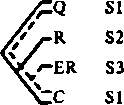I 195
Annex 2.4
Mishler's Types of Discourse
(from Mishler, 1978:283)
Examples of Types of Discourse: Different Modes of Connection
Between Interrogative Units®
1. Chaining

2. Aidiing
Did you really finish all your work before everybody else?
Yeah.
What kind of work was it?
Well. We jus had a piece of paper and it had all the names on it. And
we had to see if it was odd or even.
Do you know all the odd numbers and all the even numbers?
Uh huh.
How far up can you count?
y-Q Sl:
OJ∑R∕Q S2:
<Sc∕R Si:
>-C S2:
Whaddya mean? lie is (S) He's
(S) Is he under water?
He is. See now here’s a scuba suit on him.
1 think he’s dead.
3. Embedding

Ohhh. What’s he got on here?
(S) Skiis.
(S) Skiis.
Woooow. 1 would Jove to ski.
eThe separate functions of each utterance as question, response, and confirmation are
marked as Q, R, C. Multiple functions of utterances in different but connected
interrogative units are indicated as C∕Q or R∕Q. In the chaining example, the third
utterance functions as a confirmation m the first IU and a question in the second 1U,
«nd is marked as C∕Q. In the arching example, the se∞nd utterance is a response in the
fust IU and a question in the second, thus R∕Q; the third utterance is a confirmation in
the first and a response in the second IU, and noted as C∕R. In embedding, one response
was treated as primary and marked as R, the embedded response as ER. The notations
of (S) and underlining indicate utterances, or parts of utterances that occur at the same
time, that is, they are instances of simultaneous speech. Fragments and false starts, such
as “He is" in the arching example, are included in the typescript without punctuation.
More intriguing information
1. THE UNCERTAIN FUTURE OF THE MEXICAN MARKET FOR U.S. COTTON: IMPACT OF THE ELIMINATION OF TEXTILE AND CLOTHING QUOTAS2. Opciones de política económica en el Perú 2011-2015
3. Convergence in TFP among Italian Regions - Panel Unit Roots with Heterogeneity and Cross Sectional Dependence
4. sycnoιogιcaι spaces
5. The name is absent
6. WP 92 - An overview of women's work and employment in Azerbaijan
7. Deprivation Analysis in Declining Inner City Residential Areas: A Case Study From Izmir, Turkey.
8. The name is absent
9. The name is absent
10. THE CO-EVOLUTION OF MATTER AND CONSCIOUSNESS1